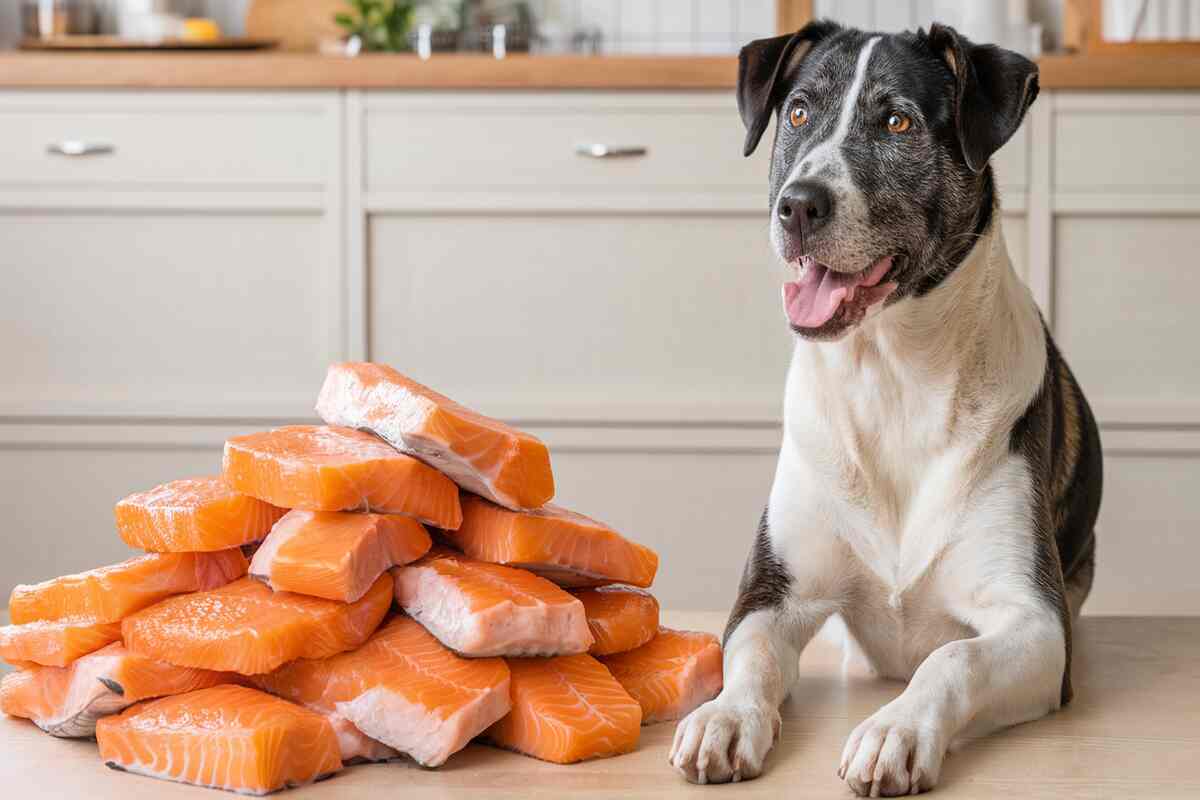Can Dogs Eat Salmon Skin? A Safe and Tasty Treat or Risky Business?
Wondering, "Can dogs eat salmon skin?" Discover if '' is safe, healthy, or risky for your furry friend in this vet-approved guide.
If you're anything like me, you've probably looked down at your plate after a delicious salmon dinner and wondered, "Can my dog eat this leftover salmon skin?" It smells amazing, looks crunchy, and your pup is giving you that please-share-it-with-me stare. But when it comes to feeding our furry friends, caution is always key.
1. What Is Salmon Skin?
Salmon skin is the outer layer of the fish that’s usually removed before serving. It’s rich in oils and nutrients and has a unique taste and texture that many humans and dogs find delicious. But before we serve it up, we need to dig deeper into whether it's truly dog-friendly.
2. Is Salmon Skin Safe for Dogs?
Yes, but with conditions. Dogs can eat salmon skin, but it must be properly cooked and served in moderation. Raw salmon skin can carry parasites and bacteria, which can be dangerous—even fatal—to dogs. Think of it like feeding your dog a raw egg from an unknown source. It might be okay, but it’s not worth the risk.
3. Nutritional Benefits of Salmon Skin

Salmon skin is like nature’s fishy multivitamin! Here are a few health perks:
- Omega-3 Fatty Acids: Great for skin, coat, and brain health.
- Protein: Supports muscle maintenance.
- B Vitamins: Aid in energy production and healthy metabolism.
- Selenium: An antioxidant that supports immune function.
Just like how spinach is a powerhouse for humans, salmon skin can be a super snack for dogs.
4. Risks and Hazards of Feeding Salmon Skin
Despite its benefits, salmon skin isn’t risk-free:
- Parasites like Neorickettsia helminthoeca: These cause salmon poisoning disease, common in the Pacific Northwest.
- High Fat Content: Too much can lead to pancreatitis.
- Salt and Seasoning: Human-prepped salmon skin often contains garlic, salt, or oil—harmful to dogs.
Always remember: what’s tasty for us can be toxic for them.
5. Raw vs Cooked Salmon Skin
Raw = Risk. Cooked = Safe. Raw salmon skin is a no-go. Always cook the skin thoroughly to kill off harmful bacteria or parasites. Baking, boiling, or grilling (without seasoning) are your best options.
6. How to Prepare Salmon Skin for Dogs
Here’s a dog-friendly recipe:
- Clean the skin – Remove any leftover scales or bones.
- No seasoning – Skip salt, garlic, and oil.
- Bake at 375°F for 10-15 minutes until crispy.
- Cool before serving.
Think of it as making dog-friendly chips!
7. How Much Is Too Much? Portion Control
Moderation is everything. One or two small strips of salmon skin once or twice a week is plenty for most dogs. Overfeeding can lead to obesity or digestive upset. A little goes a long way!
8. Allergies and Sensitivities
Some dogs have seafood allergies or sensitive stomachs. If it’s your dog’s first time trying salmon, introduce it slowly and watch for symptoms like:
- Itching
- Vomiting
- Diarrhea
- Lethargy
If you notice any of these, stop feeding and consult a vet.
9. Store-Bought vs Homemade Salmon Treats
Many pet stores now sell dehydrated salmon skin treats. While convenient, always:
- Read labels – Avoid added salt or preservatives.
- Check origin – Look for wild-caught, sustainably sourced salmon.
Homemade is great if you have the time and tools.
10. Alternatives to Salmon Skin

No salmon? No problem. Try these alternatives:
- Plain cooked fish fillets (cod, haddock, trout)
- Dehydrated sweet potato chews
- Commercial omega-3 supplements
These give your dog similar benefits without the risks.
11. Signs of Salmon Poisoning in Dogs
If your dog accidentally eats raw or spoiled salmon, watch for:
- Fever
- Vomiting
- Diarrhea
- Swollen lymph nodes
- Weakness
This is an emergency—call your vet immediately!
12. When to Avoid Giving Salmon Skin
Skip it if your dog:
- Has a history of pancreatitis
- Is overweight or on a low-fat diet
- Has known food allergies
- Is under 3 months old
Always tailor treats to your dog’s unique needs.
13. Can Puppies Eat Salmon Skin?
It’s not recommended. Puppies have sensitive digestive systems. It's better to wait until your pup is older and their gut can handle richer foods.
14. Vet Opinions on Salmon Skin
Most vets agree: salmon skin is fine in moderation—as long as it’s cooked, unseasoned, and portion-controlled. It’s not essential in a dog’s diet, but it can be a healthy, high-value treat.